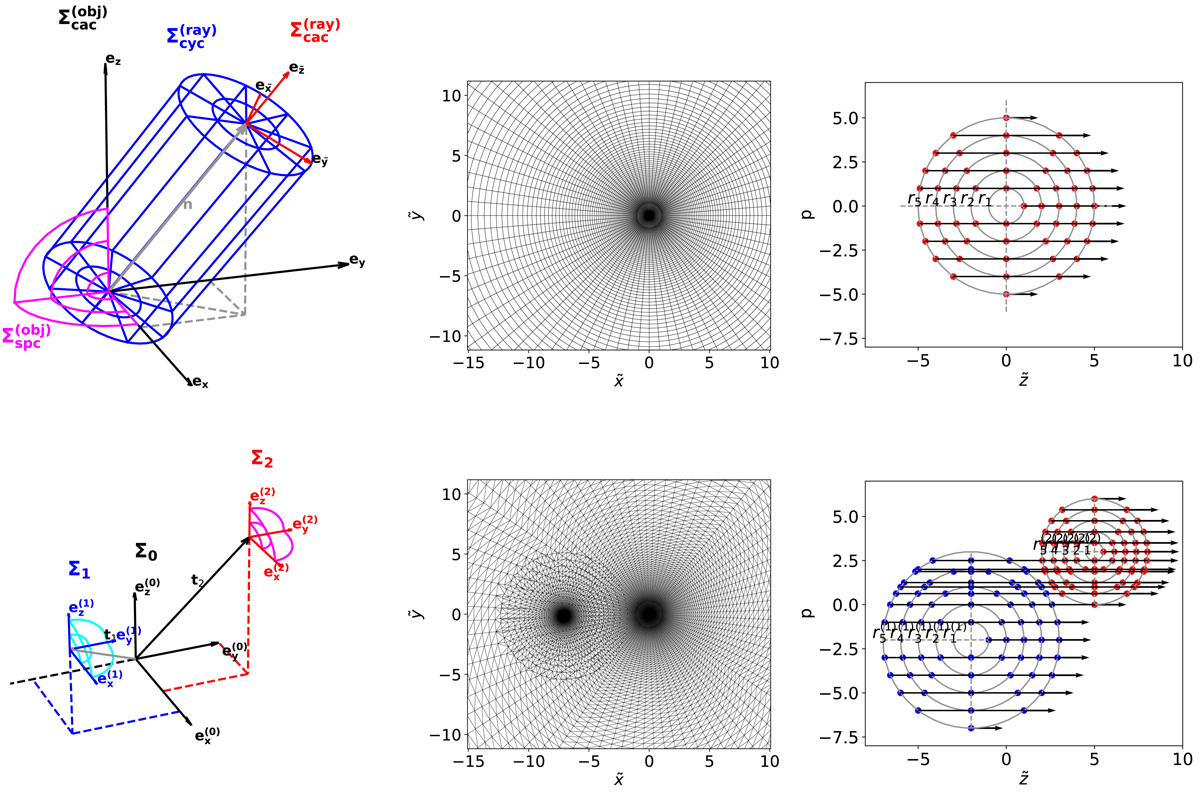Fig. 1.

Download original image
Geometry used for the single-star algorithm (top panels) and for the binary code (bottom panels). Top left panel: cylindrical coordinate system ![]() (blue) with corresponding Cartesian reference frame
(blue) with corresponding Cartesian reference frame ![]() (red) for an observer’s direction
(red) for an observer’s direction ![]() used to obtain the synthetic spectrum of a given (single) object described in a spherical coordinate system
used to obtain the synthetic spectrum of a given (single) object described in a spherical coordinate system ![]() (magenta) with corresponding Cartesian reference frame
(magenta) with corresponding Cartesian reference frame ![]() (black). Top middle panel: p − ζ (or
(black). Top middle panel: p − ζ (or ![]() -plane) of the cylindrical coordinate system (perpendicular to the observer’s direction). Top right panel: an arbitrary
-plane) of the cylindrical coordinate system (perpendicular to the observer’s direction). Top right panel: an arbitrary ![]() -slice, with
-slice, with ![]() pointing towards the observer. The grey circles indicate the radial grid of the spherical coordinate system of a considered (single) object, and the black arrows correspond to the individual rays for each impact parameter p. The radiative transfer is then performed along each ray with corresponding discretized
pointing towards the observer. The grey circles indicate the radial grid of the spherical coordinate system of a considered (single) object, and the black arrows correspond to the individual rays for each impact parameter p. The radiative transfer is then performed along each ray with corresponding discretized ![]() coordinates indicated by the red dots. Bottom left panel: two local coordinate systems Σ1 and Σ2 describing two individual objects indicated by the cyan and magenta quarter-circles, respectively. Both coordinate systems are embedded within a global coordinate system Σ0 (typically but not necessarily chosen to be the centre of mass of both objects). The vectors t1 and t2 describe the origin of the local coordinate systems in the global coordinate system. Bottom middle panel: as top middle panel, however showing the triangulation of the
coordinates indicated by the red dots. Bottom left panel: two local coordinate systems Σ1 and Σ2 describing two individual objects indicated by the cyan and magenta quarter-circles, respectively. Both coordinate systems are embedded within a global coordinate system Σ0 (typically but not necessarily chosen to be the centre of mass of both objects). The vectors t1 and t2 describe the origin of the local coordinate systems in the global coordinate system. Bottom middle panel: as top middle panel, however showing the triangulation of the ![]() -plane for an arbitrary orbital configuration in a global cylindrical coordinate system within the binary algorithm. Bottom right panel: as top right panel, but now for the binary system. The individual
-plane for an arbitrary orbital configuration in a global cylindrical coordinate system within the binary algorithm. Bottom right panel: as top right panel, but now for the binary system. The individual ![]() -rays propagating through the system of object 1 (blue) and object 2 (red) potentially need to be merged.
-rays propagating through the system of object 1 (blue) and object 2 (red) potentially need to be merged.
Current usage metrics show cumulative count of Article Views (full-text article views including HTML views, PDF and ePub downloads, according to the available data) and Abstracts Views on Vision4Press platform.
Data correspond to usage on the plateform after 2015. The current usage metrics is available 48-96 hours after online publication and is updated daily on week days.
Initial download of the metrics may take a while.


